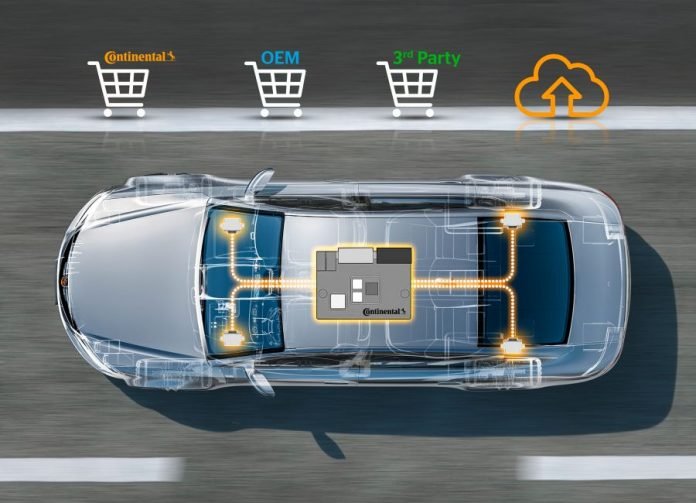The technology company Continental is driving the transition to electric mobility and supplying essential components for Volkswagen’s new electric model ID.3. With its high-performance computer, Continental is revolutionizing the vehicle’s electronic architecture. The so-called In-Car Application Server 1 (ICAS1) serves as an intelligent interface to the internet. It also forms a central component for all vehicles based on the modular electric drive system, including Chinese variants. In addition to the ID.3, it will also be used in other vehicles of the ID series such as the ID.4 from Volkswagen. Furthermore, besides this technology, Continental supplies the drum brake with integrated electromechanical parking brake function. It is a robust and corrosion-free solution that increases the lifetime service interval. The specially developed summer, all-season and winter tires EcoContact 6, WinterContact TS 850 P and AllSeasonContact reduce wear and energy consumption and thus contribute to the widest possible range of the ID.3. Moreover, a sophisticated thermal management from Continental ensures optimal range and increases the durability of the batteries in the ID.3.
Server concept revolutionizes the electronic architecture of e-vehicles
”With our High Performance Computer (HPC), the VW-electric cars are able to provide full connection and a new dimension of intelligence and comfort,” says Helmut Matschi, member of the executive board at Continental and head of the Vehicle Networking and Information business area at Continental. “Together with VW and our partners, we have brought an innovation onto the road that is groundbreaking for the entire mobility industry.”
The HPC serves as an integrated ICAS1. Continental worked closely with Elektrobit to develop the fully connected central HPC on a specially created platform for such HPC. As ICAS1 in the VW ID.3, the HPC is also a central element for the transition to a service-oriented electronics architecture. The server constitutes the central data hub and the connection point between the vehicle and the digital world. It allows for new software functions and safety updates to be installed over a wireless connection at any time in the future. Over-the-Air updates will become the norm. In addition, the innovative server concept can integrate both Volkswagen applications and third-party software. The provision of functions such as range-optimized route planning and the localization of charging stations for electric cars is simplified. Moreover, Continental has also developed the so-called “Plug and Charge” function for its ICAS1, which is used to control and simplify the vehicle charging process. The function will be available from 2021. When the charging cable is plugged in, the software in ICAS1 will be able to authenticate the registered vehicle at supported charging points and take over the charging process and its billing based on the charging contract stored in the back end.
Better performance and longer lifetime with the drum brake for e-vehicles
“Thanks to our large brake portfolio and many years of experience in this field, we have developed the optimal solutions for the greatest variety of vehicle classes. Of course, with only the highest safety requirements, since the brake components for decelerating the vehicle will remain one of the most important elements of active safety in the future,” says Dr. Bernhard Klumpp, head of the business unit Hydraulic Brake Systems at Continental. “The drum brake, as built in the ID.3, provides many benefits, particularly in the field of e-vehicles, for instance a longer service interval of up to 150,000 kilometers.” Due to the closed and sealed system, the brakes in the new VW ID.3 are distinctly less prone to corrosion. The electric drum brake with electromechanical parking brake function is based on the Simplex principle (EPB-Si): It is especially robust and requires little maintenance, which meets the increasing lifetime requirements of electric vehicles. Additionally, the electric parking brake provides the vehicle manufacturers with greater freedom and more options in the design of the vehicle interior as well as the installation of vehicle assistance systems. The brake system is moreover scalable and with this, suitable for mini and small cars as well as larger vehicles, weighing up to 3.5 tons.
Energy-saving tires and sophisticated thermal management increase the range of the ID.3
Continental wheels the VW ID.3 ex-factory. For this purpose, Volkswagen has approved summer, all-season and winter tires between 18 and 20-inch rims: The EcoContact 6 summer tires in sizes 18 to 20 inch, the AllSeasonContact in 19 inch as all-season tire and the WinterContact TS 850 P winter tires, for rims with a diameter of 18 inches tailored to the specific requirements of the ID.3. They offer a particularly low roll-resistance to save energy and enable the widest possible range between charge cycles. In addition, there is a low rolling noise for comfortable driving as well as an aerodynamic sidewall design to keep the vehicle’s air resistance low. The summer, all-season and winter tires are partly equipped with ContiSeal technology. This reliably seals tires against tread punctures from objects of up to 5 millimetres in diameter and thus prevents around 90 percent of tire damage.
Furthermore, unlike conventional vehicles, electric vehicles require many cooling circuits, as batteries function most efficiently between 20°C and 40°C. This temperature spectrum makes a longer range possible and increases battery life. In order to maintain these optimal conditions, batteries must either be heated or cooled depending on the ambient temperature. This requires sophisticated thermal management. As the only current series supplier in the world, Continental provides flexible hose lines for the ID.3’s battery temperature control as well as the heat pump for cooling with the most environmentally friendly refrigerant currently available, R744. The new hose generation offers some advantages: besides weight reduction, smaller hose line cross-sections on the high-pressure side and in the battery-cooling system contribute to the use of as little coolant fluid as possible.
The ID.3 will safely come to a standstill when it matters: The long-range radar built into the electric compact car with a range of more than 200 meters increases safety and comfort with forward-looking driver assistance systems, such as the emergency brake assist and adaptive cruise control. In combination with the drum brake, the desired speed is automatically adjusted to the traffic conditions in order to avoid accidents – all the way up to emergency braking in especially critical situations.
Small, intelligent and vital in every vehicle: Wheel speed sensors from Continental provide information on the rotational speed and direction of rotation of the individual wheels. With its newest generation of sensors, Continental also offers an intelligent solution for the ID.3, which forms the basis for numerous vehicle functions and systems such as the Electronic Stability Control (ESC) and Anti-lock Brake System (ABS) or supports the monitoring of electric drivetrains. Due to high standardization, the wheel speed sensors are particularly robust as well as flexible in the installation position and were developed according to the safety standard ISO 26262. The investment in design variations and validation is therefore significantly reduced, which leads to time to market.







